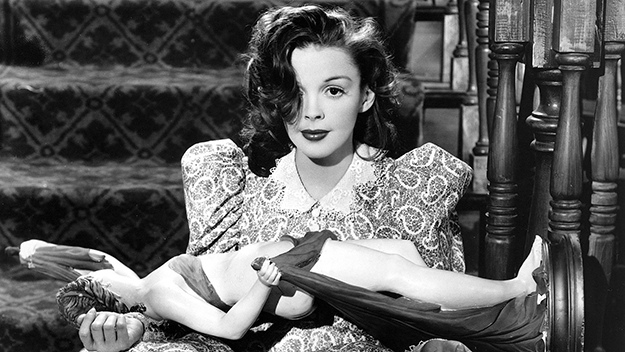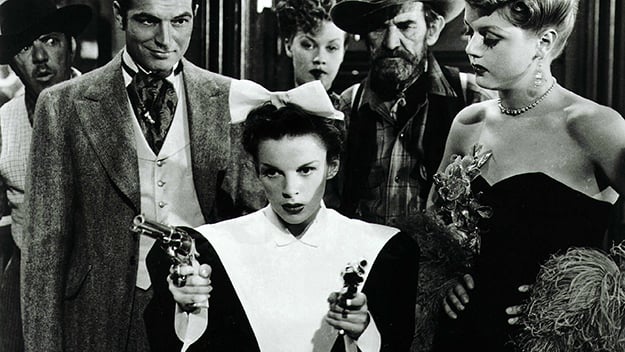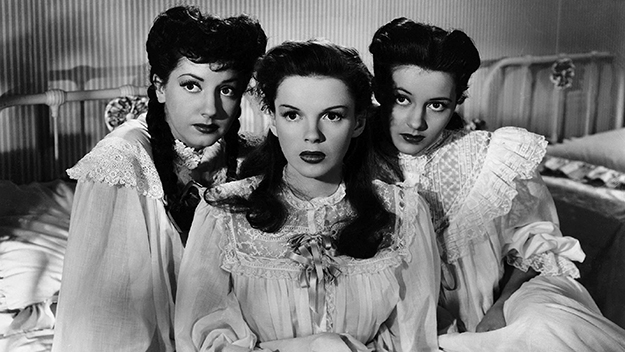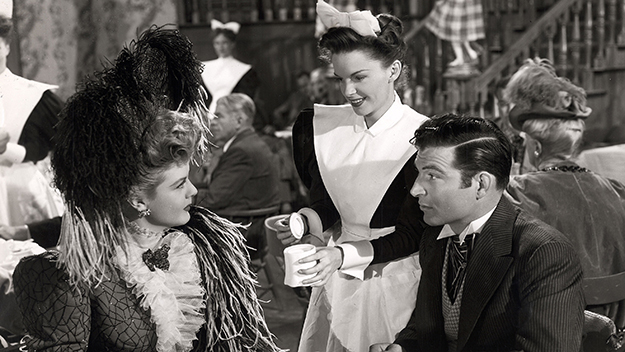Queer & Now & Then: 1946

Judy Garland in The Harvey Girls (George Sidney, 1946)
It’s been 50 years since her death, and Judy Garland still deserves better. The singing-through-tears, industry–victim incarnation of Garland is once again being trotted out for our morbid delectation in the new biopic Judy. Unsurprisingly and unfortunately, Rupert Goold’s film focuses almost exclusively on the near-end of the icon’s career, specifically her disaster-courting late-’60s gig at London’s Talk of the Town nightclub, only months before her death at a rapidly aged 47. The fault of the film’s turgidness doesn’t lie with Renée Zellweger, who does an admirable job of embodying Renee Zellweger embodying Judy Garland. Rather it’s the unyielding, voyeuristic focus on trauma, which feels like an end unto itself. Even the handful of flashbacks shuttle the viewer only to moments of her youth that created those fissures of pain that would prove unmendable. Though it gives her one final, triumphant “Over the Rainbow” reprise, the Judy in Judy comes across as little more than a showbiz casualty.
The evergreen queer appeal of Judy Garland is about so much more than victimhood, and there’s something suspect, if not distasteful, about making her downfall into the stuff of reluctant melodrama; La Vie en Rose, the Edith Piaf biopic that earned Marion Cotillard her Oscar, at least pushed past politesse into something genuinely, bravely excessive. A real challenge—and admittedly a difficult one—would be to focus on Judy Garland at her height, not her lowest lows; to try and dramatize the complexities and reconciliations of living as a performer of such mind-boggling talents and a human being saddled with such emotional burdens. Aside from the surely impossible task of finding someone to convincingly play Garland at any earlier point in her career without making it essentially a drag impersonation, such an approach would require a special ingredient heretofore unseen in dramatizations of her life: joy. The elation Garland was able to elicit in her films of the ’40s—the fullest, least compromised, and most successful decade of her adult career—is the miraculous element that evens out the crushing insecurity and tremulous vulnerability that has come to define her in books and biographical movies. The sad, pill-popping, alcohol-guzzling Judy of Judy sent me running back to that decade so I could remind myself of why she means so much to me, to gay culture, to music, to movies in general: the way she connects.
There is no grand tragedian version of Judy Garland without the MGM Judy Garland as her purposeful counterimage, the squeaky-clean starlet of the most prestigious movie studio of them all. Perception of Garland would change forever in 1950, when she was released from her MGM contract after a series of meltdowns, culminating in her having to be replaced in Annie Get Your Gun. Queer theorist Richard Dyer posits that this was the definitive break from her well-honed image of wholesome perfection, leading to a period that “made possible a reading of Garland as having a special relationship to suffering, ordinariness, normality, and it is this relationship that structures much of the gay reading of Garland.” This was the “half” of her career that included a recurring series of “comebacks,” from onscreen triumphs of suffering such as A Star Is Born (1954), Judgment at Nuremberg (1961), and I Could Go On Singing (1962), to her onstage appearances in London and at Carnegie Hall, to her Capitol Records releases, to her television shows and appearances in the ’60s. For this Judy, the Judy Garland of the ’40s became a reference point, a past life, the trauma she had to overcome but through her music had to keep on reliving, in a cruel twist of fate. In a sense, her gay fandom seems to have grown out of this dichotomy—that fruitful yet difficult period where she could have been labeled a “survivor.”

Stephen McNally, Judy Garland, and Angela Lansbury in The Harvey Girls
That Judy—the gay icon, the performer accused of emotional exhibitionism—has thus always been difficult to square with the Judy that some of us most love to watch, the supposedly carefree young woman who brought robust charm and witty self-effacement to such crystalline MGM entertainments as For Me and My Gal (1942), the underappreciated Presenting Lily Mars (1943), and Easter Parade (1948); who disallows Vincente Minnelli’s The Pirate (1948) from floating off into the ether of meta camp, and who grounds his Meet Me in St. Louis (1944) with her natural and rather startling unsentimentality. By virtue of our retrospective knowledge of her later status, her burgeoning relationship with the closeted Minnelli, and the general association of the American musical with a gay sensibility, any of these films could be recouped as a work of queerness, especially The Pirate, which has long been a sort of a bellwether in theoretical queer readings of classical Hollywood. Yet there’s another Arthur Freed Unit production, The Harvey Girls (1946), which has always struck me as offering a quintessential example of the complex Judy Garland persona, one that bridges eras, embodying her movie star effervescence yet pointing toward darker roads.
As Susan Bradley, an Ohio gal who’s answered a matrimonial ad in the newspaper and journeyed way out West, she’s tough and vulnerable, naturalist and campy, vivacious and melancholy, effortless in her movements yet uncomfortable in her clothes. Early in the film, while arriving in small Sand Rock, New Mexico, by locomotive, she reminds us that she’s not just here for love, but to see the country and to pursue her own happiness. Once she’s arrived, she and her potential husband, H. H. Hartsey, decide quickly they don’t want to marry one another: she seems a little scrawny to him, while he seems to be played by Chill Wills. With nowhere else to go, she turns in her bridal veil for an apron and goes to work as a waitress with the Harvey Girls, who are just then setting up shop in the first restaurant Sand Rock has ever had, one of the chain of restaurants that Fred Harvey set up along the Santa Fe railway line in the late 19th century. These “winsome waitresses,” as the opening card explains, “conquered the West as surely as the Davy Crocketts and the Kit Carsons—not with powder horn and rifle, but with a beefsteak and a cup of coffee.”
The Harvey Girls was a fanciful musical rendering of American Western history, and as such was a clear way to capitalize on the game-changing success of Rodgers and Hammerstein’s Oklahoma!, which was still going strong on Broadway after opening in 1943. The Harvey story had been bought from the Harvey family by MGM in 1942, originally as a non-musical vehicle for Lana Turner, but it came to be an Arthur Freed production based on the interest of Roger Edens, the studio’s musical arranger and composer all-star. It would become Garland’s first major Technicolor musical following the runaway success of Meet Me in St. Louis, and it would be built entirely around her star power. It’s clear from the very first scene that she’s the main event, as Garland, donning a powder blue dress and maize-yellow scarf, her hair fashionably pulled up, sings the gentle lullaby “In the Valley Where the Evening Sun Goes Down” while perched on the caboose of a train; the camera lovingly tracks in and out on her, sometimes demurring from her wattage, sometimes moving in like a moth to the flame.

Virginia O’Brien, Judy Garland, and Cyd Charisse in The Harvey Girls
This is soon followed by the film’s biggest number and overall high point, Harry Warren and Johnny Mercer’s Oscar-winning “On the Atchison, Topeka, and the Santa Fe,” which is reminiscent of both Meet Me in St. Louis’s effervescent standout “The Trolley Song” and Warren’s earlier hit “Chattanooga Choo Choo” in its ability to wed melody, rhythm, and lyrics to the forward motion of transportation vehicles, a distinctly American form of musical revolution. The song begins as an ensemble number, a tone and location setter that gives equal weight to a variety of principal, side, and incidental characters as the train pulls into the station: cowhands in fruit-colored ascots, town blacksmiths, and all those wannabe “winsome waitresses” who’ve come from destinations east, two of whom recite direct to camera with a knowing glance: “We were schoolmarms from Grand Rapids, ‘Mich,’ but reading, writing, ’rithmetic were not our dish!” The song climaxes by tightening in on Garland, who becomes the center of the frame, the one around which all the other performers, and a craning, arching camera, finally genuflect.
As Hollywood moved ever further away from wartime, and burrowed deeper into postwar anxieties around masculinity, such stories of women in the workplace would become increasingly rare. While The Harvey Girls might anticipate such female-driven, western movie musicals as Annie Get Your Gun (1950), Calamity Jane (1953), and The Unsinkable Molly Brown (1964), all of which gesture to ideas of female exceptionalism, there’s a particular joy in The Harvey Girls’ focus on women working together for a common goal: to give the customers “ginger-peachy” service. Garland’s Susan will gradually stumble into love with—after working through a bit of hate for—Ned Trent (broad-toothed John Hodiak, an actor whose face always looks like it belongs on a “most-wanted” poster); he’s the owner of the local saloon Alhambra and initially dismissed the Harvey House, his new competition, as “a place that sells vittles and cat-faced girls.” Yet it’s Susan’s rivalry with Alhambra’s seen-it-all showgirl Em (a wise-beyond-her-years Angela Lansbury, unbelievably only 20 at the time) that truly inhabits the core of the movie, a testy relationship between two professional women that’s ultimately revealed as fueled by mutual respect.

Angela Lansbury, Judy Garland, and Stephen McNally in The Harvey Girls
The dispute between Susan and Em functions as the film’s symbolic tug-of-war: old versus new; lawless West versus proper East; the hypersexual saloon showgirl versus the family restaurant waitress; and, in terms of music style, the randy burlesque versus the prim waltz (the latter in the showstopper “Swing Your Partner Round and Round,” complete with canted camera swoons). Of course, the family restaurant wins and the Alhambra is run out of town, anticipating the homogenization of mass culture. That Garland here represents that wholesomeness—the song in the happy, beating heart of America—is entirely in keeping with her MGM image of the period. Yet The Harvey Girls also marks a crucial in-between stage for her persona. As her leading lady status was being cemented, her insecurities rose, the darkness encroached.
In the film’s strangest and most emotionally ambivalent moment, Susan joins two of her fellow waitresses, played by Virginia O’Brien and a young Cyd Charisse in her first speaking role—though her singing was dubbed. Pirouetting on their boarding house’s porch at night in frilly nightgowns, they sing a quiet ballad about their fears and failures in life and love: “And it’s cold, cold, cold, and we’ll soon be old, alas and alack it’s a great big world.” As the women climb into their respective beds, and the music gently fades out, a shocking gunshot blast breaks the ceiling lamp; the rupture signals the end of the scene and the end of the song, but also we might now see it as representative of a more central underlying shift.
On set, Garland’s erratic behavior escalated; her daily lateness, cancelations, sicknesses, and lack of communication extensively documented, signaling an increasingly strained relationship with the studio. Garland herself later said she was “a nervous wreck” during the shoot, and that “Every day I went to work with tears in my eyes. Work gave me no pleasure. The studio had become a haunted house for me.” There’s no doubt a seriousness of intent to her performance, as even in her lightest roles, Garland always offers an insistent sobriety. Yet as the intrepid Susan Bradley she maintains a bright-eyed optimism and frontier promise that cuts through the melancholy. For this essay I could have easily chosen to highlight one of the more overtly or at least academically gay Garland films, like The Wizard of Oz, The Pirate, or A Star Is Born, yet the queer charge of The Harvey Girls is, for me, undeniable. As Dyer reminds us, Garland’s gay appeal was long dependent on the negotiation of opposite emotional registers, as represented in her recurring, singing-through-tears performances of the standbys “When You’re Smiling” and “Get Happy.” The Harvey Girls may be an often broad, frothy entertainment, but it gets at the essential dichotomy of the Garland persona. One only needs the miracle of her presence, not the sting of her tragic downfall, to fully comprehend why she endures.
Michael Koresky is the Director of Editorial and Creative Strategy at Film Society of Lincoln Center; the co-founder and co-editor of Reverse Shot; a frequent contributor to the Criterion Collection; and the author of the book Terence Davies, published by University of Illinois Press.







